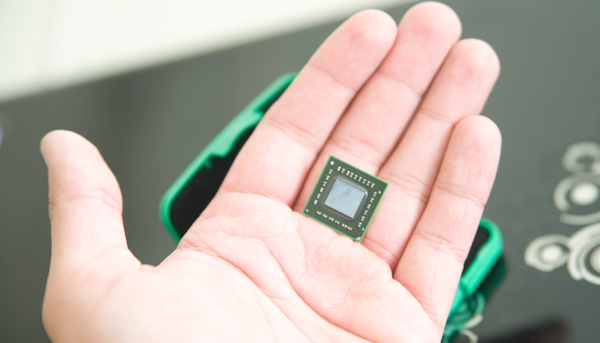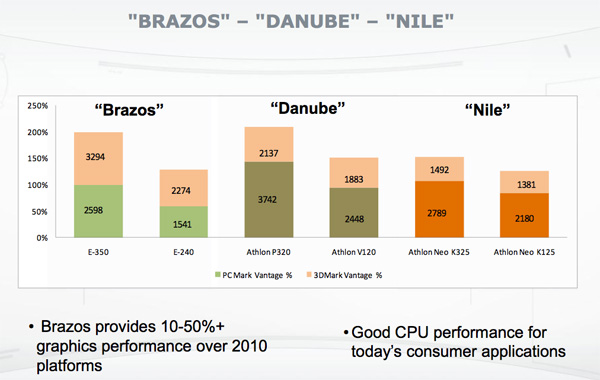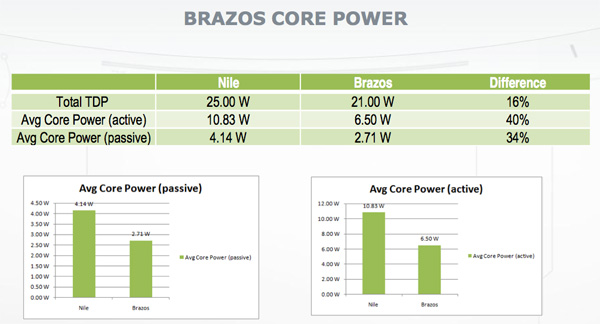The Brazos Performance Preview: AMD E-350 Benchmarked
by Anand Lal Shimpi on November 16, 2010 12:01 AM ESTSetting Performance Expectations
AMD provided this slide of PCMark Vantage and 3DMark Vantage performance of Brazos compared to its existing mobile platforms (Danube and Nile):
If you look at the PCMark Vantage numbers you'll see that AMD's E-350 provides roughly the same performance as an Athlon V120. That's a single core, 45nm chip running at 2.2GHz with a 512KB L2 cache. Or compared to a dual core processor, it's within striking distance of the Athlon Neo K325 which features two cores running at 1.3GHz and 1MB L2 per core. The GPU performance however tells a very important story. While AMD's previous platforms offered a great deal of CPU performance and an arguably imbalanced amount of GPU performance, Brazos almost does the opposite. You get a slower CPU than most existing mainstream platforms, but a much better GPU.
In the sub-$500 market, you're not going to get much in the way of a discrete GPU. What AMD is hoping for is that you'll be happy enough with Brazos' CPU performance and be sold on its GPU performance and total power consumption. From AMD's standpoint, there's not much expense involved in producing a Zacate/Ontario APU, making Brazos a nice way of capitalizing on mainstream platforms. The 75mm2 die itself is smaller than most discrete GPUs as well as anything Intel is selling into these market segments.

AMD's Zacate APU, 19mm x 19mm package, 413 balls, 75mm^2 die
The Comparison
Brazos, like Atom, will fight a two front war. On the one hand you have the price comparison. The E-350 will be found in notebooks in the $400 - $500 range according to AMD. That puts it up against mainstream notebooks with 2.2GHz Intel Pentium DC and 2.26GHz Core i3-350M processors. Against these platforms, Brazos won't stand a chance as far as CPU performance goes but it should do very well in GPU bound games. I've included results from a 2.2GHz Pentium dual-core part (1MB L2 cache) as well as a simulated Core i3-350M in the mobile IGP comparison.
The other front is, of course, the ultraportable space. Here you'll see the E-350 go head to head with dual-core Atom, Core 2 ULV and Arrandale ULV parts. AMD's CPU performance should be much more competitive here. From this camp we've got the Atom D510 (close enough to the N550) and a simulated Core i3-330UM. The expectations here are better CPU performance than Atom, but lower than Arrandale ULV. GPU performance should easily trump both.












207 Comments
View All Comments
legoman666 - Tuesday, November 16, 2010 - link
are missing.Anand Lal Shimpi - Tuesday, November 16, 2010 - link
Power consumption was listed at the end of the first page. The systems used throughout the rest of the article were based on desktop hardware, so it didn't make sense to compare to those numbers (the Brazos numbers include the test platform's LCD display). We'll have to wait for final notebook hardware to do real comparisons to competing notebook platforms. But at 25 - 30W for the entire system (including display) under load, Brazos is definitely in the right league.Take care,
Anand
Sc4freak - Tuesday, November 16, 2010 - link
Still seems to be missing something from page 3:"When it comes to power consumption however, the E-350 can't be touched. I measured max system power consumption at "
And then it just cuts off.
Anand Lal Shimpi - Tuesday, November 16, 2010 - link
er, oops...fixed :)Take care,
Anand
jensend - Tuesday, November 16, 2010 - link
Hm. From the third page:"the rest of the desktop platforms here consume much more than that at idle (much less under load)."
Unless the desktop platforms really suck much more than 25W idling and much less than 25 under load, this isn't exactly fixed.
I find it odd that you're even troubling to compare this to systems which suck tons more juice and not even throwing up a power consumption chart. I mean, we could certainly find that Brazos performance is rather limited compared to a Gulftown with 3xSLI GF 580s, but that's not going to tell us a lot about what makes a better laptop. If you did a performance vs. power draw scatter chart or something that'd be a lot more interesting.
Sure, it's a little bit apples-to-oranges since you've chosen to compare it to desktop systems. But maybe that should make you reconsider what you're comparing it to (don't you have a good number of laptops around?) rather than leaving power consumption data out of the picture.
quiksilvr - Tuesday, November 16, 2010 - link
Soprano'dsinigami - Wednesday, November 17, 2010 - link
uh, since there were so many missing parts to the article, maybe you are missing some charts on page 4 or something? because i only see three, and against the Clarkdale, the zacate wins only the first one, ties on the second one, and loses on the third. With only one win, that page's headline should NOT say it's faster than Clarkdale!you could say that the Clarkdale IGP wins or ties the zacate on two out of three gaming benchmarks, and declare it faster.
sheesh, is that some biasedness, or just wishful thinking?
wiak - Tuesday, November 16, 2010 - link
is it even suposed to be competive with E4400 anyway?, isnt the whole point of it to be power efficient, faster, use less power and totally own atom in graphics/video department?Danube is amd's mainstream competition to E4400, Core 2, Core i3, i5 etc
Brazos is amd's low power competition to atom
wiak - Tuesday, November 16, 2010 - link
correction: E2200 but E4400 aint that far away :PDark_Archonis - Tuesday, November 16, 2010 - link
... Except it does not use less power than an Atom platform. It uses more power than an Atom platform. Also as the benchmarks show, performance-wise it's barely faster than an Atom D510 in some situations.